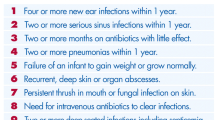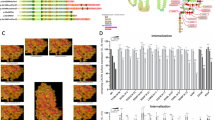Abstract
Purpose
The United States Immunodeficiency Network (USIDNET) patient registry was used to characterize the presentation, genetics, phenotypes, and treatment of patients with Hyper IgM Syndrome (HIGM).
Methods
The USIDNET Registry was queried for HIGM patient data collected from October 1992 to July 2015. Data fields included demographics, criteria for diagnosis, pedigree analysis, mutations, clinical features, treatment and transplant records, laboratory findings, and mortality.
Results
Fifty-two physicians entered data from 145 patients of ages 2 months to 62 years (median 12 years); 131 were males. Using patients’ age at last entry, data from 2072 patient years are included. Mutations were recorded for 85 subjects; 82 were in CD40LG. Eighteen subjects had non-X-linked HIGM. 40 % had a normal serum IgM and 15 %, normal IgA. Infections were reported for 91 %, with pulmonary, ear, and sinus infections being the most common. 42 % had Pneumocystis jirovecii pneumonia; 6 % had Cryptosporidium. 41 % had neutropenia. 78 % experienced non-infectious complications: chronic diarrhea (n = 22), aphthous ulcers (n = 28), and neoplasms (n = 8) including colon cancer, adrenal adenoma, liver adenocarcinoma, pancreatic carcinoid, acute myeloid leukemia, hepatoma, and, in a female with an autosomal dominant gain of function mutation in PIK3CD, an ovarian dysgerminoma. Thirteen patients had a hematopoietic marrow or stem cell transplant; three had solid organ transplants. Thirteen were known to have died (median age = 14 years).
Conclusions
Analysis of the USIDNET Registry provides data on the common clinical features of this rare syndrome, and in contrast with previously published data, demonstrates longer survival times and reduced gastrointestinal manifestations.




Similar content being viewed by others
References
Davies EG, Thrasher AJ. Update on the hyper immunoglobulin M syndromes. Br J Haematol. 2010;149(2):167–80. doi:10.1111/j.1365-2141.2010.08077.x.
Durandy A, Kracker S. Immunoglobulin class-switch recombination deficiencies. Arthritis Res Ther. 2012;14(4):218. doi:10.1186/ar3904.
Qamar N, Fuleihan RL. The hyper IgM syndromes. Clin Rev Allergy Immunol. 2014;46(2):120–30. doi:10.1007/s12016-013-8378-7.
Picard C, Al-Herz W, Bousfiha A, Casanova JL, Chatila T, Conley ME, et al. Primary immunodeficiency diseases: an update on the classification from the International Union of Immunological Societies Expert committee for Primary Immunodeficiency 2015. J Clin Immunol. 2015. doi:10.1007/s10875-015-0201-1.
Winkelstein JA, Marino MC, Ochs H, Fuleihan R, Scholl PR, Geha R, et al. The X-linked hyper-IgM syndrome: clinical and immunologic features of 79 patients. Medicine (Baltimore). 2003;82(6):373–84. doi:10.1097/01.md.0000100046.06009.b0.
Levy J, Espanol-Boren T, Thomas C, Fischer A, Tovo P, Bordigoni P, et al. Clinical spectrum of X-linked hyper-IgM syndrome. J Pediatr. 1997;131(1 Pt 1):47–54.
Jesus AA, Duarte AJ, Oliveira JB. Autoimmunity in hyper-IgM syndrome. J Clin Immunol. 2008;28 Suppl 1:S62–6. doi:10.1007/s10875-008-9171-x.
Hirbod-Mobarakeh A, Aghamohammadi A, Rezaei N. Immunoglobulin class switch recombination deficiency type 1 or CD40 ligand deficiency: from bedside to bench and back again. Expert Rev Clin Immunol. 2014;10(1):91–105. doi:10.1586/1744666x.2014.864554.
Fuleihan R, Ramesh N, Loh R, Jabara H, Rosen RS, Chatila T, et al. Defective expression of the CD40 ligand in X chromosome-linked immunoglobulin deficiency with normal or elevated IgM. Proc Natl Acad Sci U S A. 1993;90(6):2170–3.
Aruffo A, Farrington M, Hollenbaugh D, Li X, Milatovich A, Nonoyama S, et al. The CD40 ligand, gp39, is defective in activated T cells from patients with X-linked hyper-IgM syndrome. Cell. 1993;72(2):291–300.
Lougaris V, Badolato R, Ferrari S, Plebani A. Hyper immunoglobulin M syndrome due to CD40 deficiency: clinical, molecular, and immunological features. Immunol Rev. 2005;203:48–66. doi:10.1111/j.0105-2896.2005.00229.x.
Revy P, Muto T, Levy Y, Geissmann F, Plebani A, Sanal O, et al. Activation-induced cytidine deaminase (AID) deficiency causes the autosomal recessive form of the Hyper-IgM syndrome (HIGM2). Cell. 2000;102(5):565–75.
Imai K, Slupphaug G, Lee WI, Revy P, Nonoyama S, Catalan N, et al. Human uracil-DNA glycosylase deficiency associated with profoundly impaired immunoglobulin class-switch recombination. Nat Immunol. 2003;4(10):1023–8. doi:10.1038/ni974.
Minegishi Y, Lavoie A, Cunningham-Rundles C, Bédard P-M, Hébert J, Côté L, et al. Mutations in activation-induced cytidine deaminase in patients with hyper IgM syndrome. Clin Immunol. 2000;97(3):203–10. doi:10.1006/clim.2000.4956.
Cabral-Marques O, Arslanian C, Ramos RN, Morato M, Schimke L, Soeiro Pereira PV, et al. Dendritic cells from X-linked hyper-IgM patients present impaired responses to Candida albicans and Paracoccidioides brasiliensis. J Allergy Clin Immunol. 2012;129(3):778–86. doi:10.1016/j.jaci.2011.10.026.
Angulo I, Vadas O, Garçon F, Banham-Hall E, Plagnol V, Leahy TR, et al. Phosphoinositide 3-kinase δ gene mutation predisposes to respiratory infection and airway damage. Science. 2013;342(6160):866–71. doi:10.1126/science.1243292.
Lucas CL, Kuehn HS, Zhao F, Niemela JE, Deenick EK, Palendira U, et al. Dominant-activating germline mutations in the gene encoding the PI(3)K catalytic subunit p110delta result in T cell senescence and human immunodeficiency. Nat Immunol. 2014;15(1):88–97. doi:10.1038/ni.2771.
Crank MC, Grossman JK, Moir S, Pittaluga S, Buckner CM, Kardava L, et al. Mutations in PIK3CD can cause hyper IgM syndrome (HIGM) associated with increased cancer susceptibility. J Clin Immunol. 2014;34(3):272–6. doi:10.1007/s10875-014-0012-9.
Kracker S, Curtis J, Ibrahim MA, Sediva A, Salisbury J, Campr V, et al. Occurrence of B-cell lymphomas in patients with activated phosphoinositide 3-kinase delta syndrome. J Allergy Clin Immunol. 2014;134(1):233–6. doi:10.1016/j.jaci.2014.02.020.
Zonana J, Elder ME, Schneider LC, Orlow SJ, Moss C, Golabi M, et al. A novel X-linked disorder of immune deficiency and hypohidrotic ectodermal dysplasia is allelic to incontinentia pigmenti and due to mutations in IKK-gamma (NEMO). Am J Hum Genet. 2000;67(6):1555–62. doi:10.1086/316914.
Sullivan KE, Puck JM, Notarangelo LD, Fuleihan R, Caulder T, Wang C, et al. USIDNET: a strategy to build a community of clinical immunologists. J Clin Immunol. 2014;34(4):428–35. doi:10.1007/s10875-014-0028-1.
Lee WI, Torgerson TR, Schumacher MJ, Yel L, Zhu Q, Ochs HD. Molecular analysis of a large cohort of patients with the hyper immunoglobulin M (IgM) syndrome. Blood. 2005;105(5):1881–90. doi:10.1182/blood-2003-12-4420.
Cabral-Marques O, Klaver S, Schimke LF, Ascendino EH, Khan TA, Pereira PV, et al. First report of the hyper-IgM syndrome Registry of the Latin American Society for Immunodeficiencies: novel mutations, unique infections, and outcomes. J Clin Immunol. 2014;34(2):146–56. doi:10.1007/s10875-013-9980-4.
Shearer WT, Rosenblatt HM, Gelman RS, Oyomopito R, Plaeger S, Stiehm ER, et al. Lymphocyte subsets in healthy children from birth through 18 years of age: the pediatric AIDS Clinical Trials Group P1009 study. J Allergy Clin Immunol. 2003;112(5):973–80. doi:10.1016/j.jaci.2003.07.003.
Etzioni A, Ochs HD. The hyper IgM syndrome—an evolving story. Pediatr Res. 2004;56(4):519–25. doi:10.1203/01.PDR.0000139318.65842.4A.
He B, Santamaria R, Xu W, Cols M, Chen K, Puga I, et al. The transmembrane activator TACI triggers immunoglobulin class switching by activating B cells through the adaptor MyD88. Nat Immunol. 2010;11(9):836–45. doi:10.1038/ni.1914.
McLauchlin J, Amar CF, Pedraza-Diaz S, Mieli-Vergani G, Hadzic N, Davies EG. Polymerase chain reaction-based diagnosis of infection with Cryptosporidium in children with primary immunodeficiencies. Pediatr Infect Dis J. 2003;22(4):329–35. doi:10.1097/01.inf.0000059402.81025.cd.
Hayward AR, Levy J, Facchetti F, Notarangelo L, Ochs HD, Etzioni A, et al. Cholangiopathy and tumors of the pancreas, liver, and biliary tree in boys with X-linked immunodeficiency with hyper-IgM. J Immunol. 1997;158(2):977–83.
De la Morena M, Leonard D. Long term clinical outcomes of patients with X-Linked Hyper IgM Syndrome, an international collaborative study. 16th Biennial Meeting of the European Society for Immunodeficiencies; October 31, 2014; Prague, Czech Republic: European Society for Immunodeficiencies; 2014.
Allewelt H, Martin PL, Szabolcs P, Chao N, Buckley R, Parikh S. Hematopoietic stem cell transplantation for CD40 ligand deficiency: single institution experience. Pediatr Blood Cancer. 2015. doi:10.1002/pbc.25711.
Mitsui-Sekinaka K, Imai K, Sato H, Tomizawa D, Kajiwara M, Nagasawa M, et al. Clinical features and hematopoietic stem cell transplantations for CD40 ligand deficiency in Japan. J Allergy Clin Immunol. 2015;136(4):1018–24. doi:10.1016/j.jaci.2015.02.020.
Lin Q, Rohrer J, Allen RC, Larch M. A single strand conformation polymorphism study of CD40 ligand. Efficient mutation analysis and carrier detection for X-linked hyper IgM syndrome. J Clin Investig. 1996;97(1):196–201. doi:10.1172/JCI118389.
Jain A, Atkinson TP, Lipsky PE, Slater JE, Nelson DL, Strober W. Defects of T-cell effector function and post-thymic maturation in X-linked hyper-IgM syndrome. J Clin Invest. 1999;103(8):1151–8. doi:10.1172/jci5891.
Seyama K, Nonoyama S, Gangsaas I, Hollenbaugh D, Pabst HF, Aruffo A, et al. Mutations of the CD40 ligand gene and its effect on CD40 ligand expression in patients with X-linked hyper IgM syndrome. Blood. 1998;92(7):2421–34.
Duplantier JE, Seyama K, Day NK, Hitchcock R, Nelson Jr RP, Ochs HD, et al. Immunologic reconstitution following bone marrow transplantation for X-linked hyper IgM syndrome. Clin Immunol (Orlando, Fla). 2001;98(3):313–8. doi:10.1006/clim.2000.4994.
Scholl PR, O’Gorman MR, Pachman LM, Pachman LM, Haut P, Haut P, et al. Correction of neutropenia and hypogammaglobulinemia in X-linked hyper-IgM syndrome by allogeneic bone marrow transplantation. Bone Marrow Transplant. 1998;22(12):1215–8.
Hollenbaugh D, Wu LH, Ochs HD, Ochs HD, Nonoyama S, Nonoyama S, et al. The random inactivation of the X chromosome carrying the defective gene responsible for X-linked hyper IgM syndrome (X-HIM) in female carriers of HIGM1. J Clin Investig. 1994;94(2):616–22. doi:10.1172/JCI117377.
Allen RC, Armitage RJ, Conley ME, Rosenblatt H, Jenkins NA, Copeland NG, et al. CD40 ligand gene defects responsible for X-linked hyper-IgM syndrome. Science. 1993;259(5097):990–3.
Ramesh N, Fuleihan R, Ramesh V, Lederman S, Yellin MJ, Sharma S, et al. Deletions in the ligand for CD40 in X-linked immunoglobulin deficiency with normal or elevated IgM (HIGMX-1). Int Immunol. 1993;5(7):769–73. doi:10.1093/intimm/5.7.769.
Chu YW, Marin E, Fuleihan R, Ramesh N, Rosen FS, Geha RS, et al. Somatic mutation of human immunoglobulin V genes in the X-linked HyperIgM syndrome. J Clin Investig. 1995;95(3):1389–93.
Acknowledgments
This work was supported by the National Institutes of Health, AI 101093, AI-086037, AI-48693, T32-GM007280, The Jeffrey Modell Foundation, and the David S Gottesman Immunology Chair. We gratefully acknowledge the enthusiasm, expertise, and dedication of Tara Caulder, USIDNET Project Director, and Marla Goldsmith, USIDNET Registry Manager.
Author information
Authors and Affiliations
Corresponding author
Additional information
*Additional USIDNET contributors: O-Neill Shigeoka, Ann; Brasher, George W; Chen, Karin; Derauf, Christian; Duplantier, John E; Greene, Jeffrey M; Rosen, Fred S; Schneider, Lynda C; Schuval, Susan; Winkelstein, Jerry A; Cleary, Thomas G; Day, Noorbibi K; Fikrig, Senih; Filipovich, Alexandra H; Gern, James E; Greaves, Kristen C; Hilman, Bettina C; Huttenlocher, Anna; Infante, Anthony J; Irani, Anne-Marie A; Jain, Ashish; Kobayashi, Roger H; Kosinski, S Mark; Lawton, Alexander R; Lederman, Howard M; McGeady, Stephen J; Menon, Prem K; Muskat, Mica; Pahwa, Savita; Patel C, Niraj; Reid, Tanya E; Saulsbury, Frank T; Slater, Jay E; Sleasman, John W; Suez, Daniel; Uygungil, Burcin; Venkat, Geeta; and Wong, Duane W
Rights and permissions
About this article
Cite this article
Leven, E.A., Maffucci, P., Ochs, H.D. et al. Hyper IgM Syndrome: a Report from the USIDNET Registry. J Clin Immunol 36, 490–501 (2016). https://doi.org/10.1007/s10875-016-0291-4
Received:
Accepted:
Published:
Issue Date:
DOI: https://doi.org/10.1007/s10875-016-0291-4




